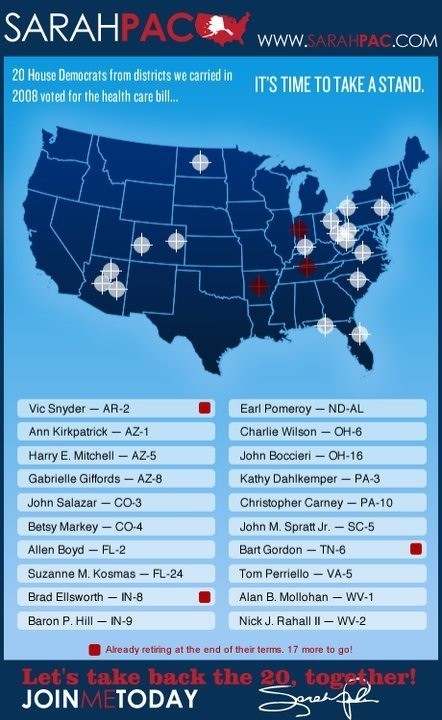US commentators are currently debating whether the man accused of killing six people, including a federal judge, wounding 13 and shooting Democrats congresswoman Gabrielle Giffords in the head is simply a crazed individual or whether his violent act was a product of increasingly violent political rhetoric and imagery, imagery like these Sarah Palin campaign crosshair posters:


But as violence in political rhetoric is brought into question, there are still very sketchy details coming to hand about the accused shooter, 22-year-old Jared Loughner.


When asked if Giffords had any enemies soon after the shooting, her father replied “Yeah, the whole Tea Party.”
But so far no connection between the Tea Party and Loughner has been established.
You can watch a bizarre YouTube clip apparently made by Loughner as an introduction to himself here, where he writes “I know who is listening. Government Officials, and the People. Nearly all the people, who don’t know this accurate information of a new currency, aren’t aware of mind control and brainwash methods. If I have my civil rights, then this message wouldn’t have happen (sic).”
Many commentators have been referencing Palin’s “Don’t react, reload!” tweet. But both the poster and the tweets date back to March 2010. And as The Washington Independent‘s David Weigel points out, Palin’s “don’t react, reload” tweet isn’t an call to bear arms. “…That’s a reference to what, according to Palin, is a family witticism. The final chapter of Going Rogue begins with a quote from her father, Chuck Heath: ‘Sarah’s not retreating; she’s reloading!'”
Palin was quick to offer her condolences for the Arizona shootings on her Facebook page.
Paul Krugman at the New York Times wasn’t impressed: “I see that Sarah Palin has called the shooting ‘tragic’. OK, a bit of history: right-wingers went wild over anyone who called 9/11 a tragedy, insisting that it wasn’t a tragedy, it was an atrocity.”
The local county sheriff Clarence Dupnik came out immediately after the shootings and declared “When you look at unbalanced people, how they respond to the vitriol that comes out of certain mouths about tearing down the government. The anger, the hatred, the bigotry that goes on in this country is getting to be outrageous… And unfortunately, Arizona I think has become sort of the capital. We have become the mecca for prejudice and bigotry.”
When asked if it was this prejudice and bigotry that caused the violence, Dupnik replied “All I can tell you is that there’s reason to believe that this individual may have a mental issue. And I think that people who are unbalanced are especially susceptible to vitriol.”
Harsh new anti-immigration laws — which insisted immigrants must always carry their papers and gave police new abilities to charge suspected “illegals” — dominated the political agenda in Arizona in 2010. Giffords voted against these reforms. And as Chris McGreal explains in The Guardian, Gifford has struggled with Tea Party rage against her in the past, thanks to her support of healthcare and her stance against Arizona’s immigration laws. Her office was ransacked not long after Palin’s infamous cross-hair posters came out.
Another alarming incident with violent overtones occurred when her opponent in the recent election, Tea Party backed Jesse Kelly — whom Giffords only narrowly beat — advertised a campaign event, with brochures that read: “Get on Target for Victory in November. Help remove Gabrielle Giffords from office. Shoot a fully automatic M16 with Jesse Kelly.”
Howard Kurtz expresses incredulity that Palin was truly attempting to incite violence, writing in the Daily Beast about the proliferation of military terminology in the media:
“Let’s be honest: Journalists often use military terminology in describing campaigns. We talk about the air war, the bombshells, targeting politicians, knocking them off, candidates returning fire or being out of ammunition. So we shouldn’t act shocked when politicians do the same thing. Obviously, Palin should have used dots or asterisks on her map. But does anyone seriously believe she was trying to incite violence?”
Conservative blogger Erick Erickson also writes on the dangers of blaming the Tea Party movement on RedState:
“It should not be, but the media, under the guise of ‘a full exposition’ of the evil in Arizona, is back to subtly and not so subtly pinning the blame for the attempted assassination of the Congresswoman and the related shootings on the Tea Party movement, Sarah Palin, Rush Limbaugh, Glenn Beck, me, you, and everyone right of centre…
Ironically, by perpetuating the lie — by even treating it as a legitimate topic of consideration to revisit the accusations of violence and hate the media tried to run with prior to the November election — that the Right and the Tea Party incited this evil act, the Left and media may very well incite violence against the Right.”
But there’s a reason we call killings or attempted killings of political figures “assassinations”. They are an inherently political act, writes James Fallows in The Atlantic:
“It is legitimate to discuss whether there is a connection between that tone and actual outbursts of violence, whatever the motivations of this killer turn out to be. At a minimum, it will be harder for anyone to talk — on rallies, on cable TV, in ads — about ‘eliminating’ opponents, or to bring rifles to political meetings, or to say “don’t retreat, reload.”
This is a turning point, an incident that will determine the US political landscape moving forward, argue many commentators.
“The more pressing question, though, is where this all ends — whether we will begin to re-evaluate the piercing pitch of our political debate in the wake of Saturday’s shooting, or whether we are hurtling unstoppably into a frightening period more like the late 1960s”, argues Matt Bai in the New York Times.








These mass killings in the US will never stop. Its just too easy to walk into your local Kmart and get a gun. In some states you have to wait 2 days to take it, to prevent rage attacks.
You can go to gun alleys in Florida and hand over your Australian divers licence and get a machine gun, saturday night special, whatever you like and shoot in a indoor range. You could even pop everyone else in there before anyone could stop you. Its insane.
The gun lobby is too strong in the US. Its a shame and a tragedy, but it will happen again and again.
This has nothing to do with political debate or gun laws. America needs to face up to the reality that in certain sections of their country there is a large populace of just really stupid people. For decades, every aspect of their lives have been controlled by rules and regulations and where dumb people are given responsibility way above their station in life so those above won’t get sued. So with all these rules and regulations, everyone in America doesn’t have to think and hence evolution done its work with the American brain. This fact was highlighted to me in a recent trip I did there. I was pleading with an American Government Official to use some common sense when he responded to me with – You don’t need common sense sir when there are rules. Says it all really.
I’m sorry to say this but 99% of the Australian media and a large percentage of the American media and public have completely lost the plot and perspective on this issue. It has absolutely nothing to do with politics except for the victim being a politician.
A mentally disturbed person is simply that, disturbed. There is absolutely no rationalization of their reasoning for carrying out tragic incidents like this. Anything and everything is a trigger. Based on this persons ranting’s, if it wasn’t a politician it would have been some other high profile person or maybe just a group of random people. This is simply the deranged nature of this type of paranoia.
I am just shocked at how ignorant and bigoted the majority of people are, continuing to fuel this mass hysteria of blaming this sad incident on ‘politics’. The vitriol in US politics right now is a separate issue and no more or less a trigger for this deranged person. I understand the AZ Sheriff is emotional and his statement about the vitriol ‘causing’ this is just a knee jerk, emotional reaction. Yes, the vitriol needs to stop but it is not the cause of this terrible shooting.
The left are as bad as the right and America, Australia and the rest of the world and importantly the media seem to have completely lost the perspective of the shooter simply being mentally disturbed.
From all of the background profiles on the shooter so far, he was nothing more than a very disturbed person and has been for a very long time.
We have heard all this before; violence is caused by music, movies, TV and books and it is claimed that these mediums ‘incite’ or ‘inspire’ a person to carry out a violent act. Now we are hearing it is the ‘political vitriol’ which caused this shooter to carry out this tragic act. It has nothing and everything to do with all of these things but you can’t use any one thing as the cause.
I’m hearing the left say the shooter was a ‘Teapublican terrorist’…what a stupid and ignorant thing to say and it just demonstrates that both sides of politics are as bad as each other but most importantly it demonstrates how much perspective and sanity has been lost around this event.
Please people, stop the hysteria and put this in its rightful perspective. A disturbed person will carry out acts like this simply because they do.
The debate and discussion should be around mental health, gun control, can risks be identified through social networks and other root cause issues.
The vitriol in politics is an entirely separate issue which must also be addressed, but please let us not confuse the two or we get nowhere on understanding and solving why this deranged person murdered these innocent people.
Apathy
How could we empirically test your explanation? I would want to see evidence that the level of rules in the USa is greatly different from that in any other country with complex social systems or that the spread of the level of intelligence is greatly different from that in other countries of similar socio-economic character.
The USA is distinctly different from countries such as Canada, Australia, the UK in terms of its gun laws access to weapons that facilitate terrorism and a culture that has glorified the use of violence.
This on face value has EVERYTHING to do with political rhetoric of the Tea Party. They have been promoting a revolution to take back their country and have oversteped the marrk so many times. They behave like the lunitic fringe and as public figures they seriously have a responsibility to be more measured with their political messages. It was only a matter of time before someone took it all as ‘gospel’.